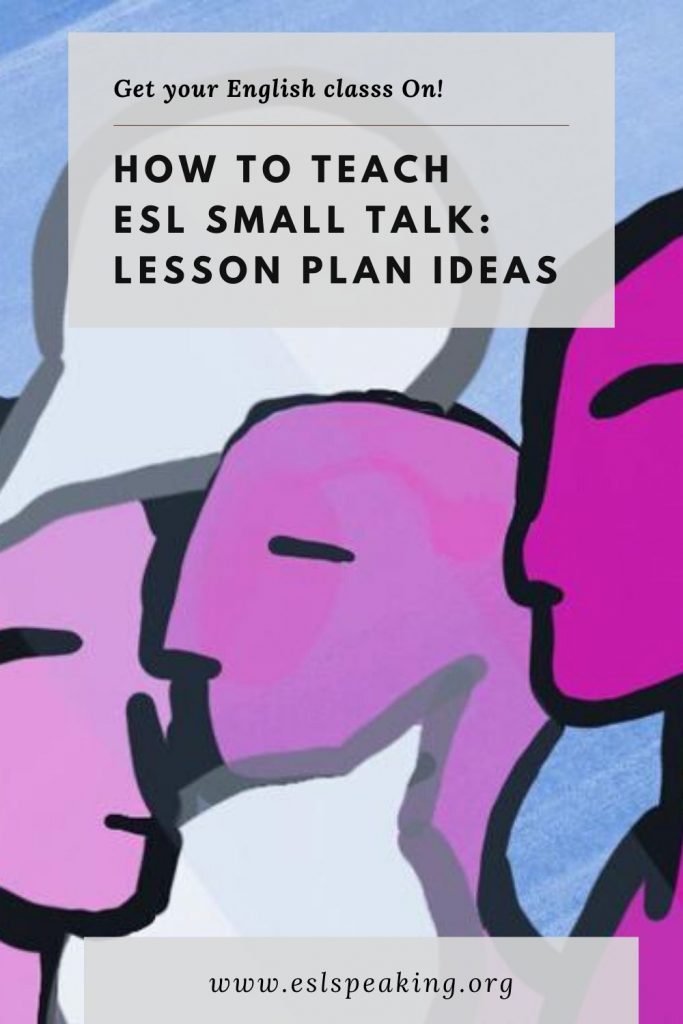Are you looking for an interesting, engaging way to have your students to get some practice with ESL small talk? It’s an important but often overlooked skill because it’s hard to design interesting activities and games that practice this. Read on for the best small talk ESL activities and games.

ESL Small Talk
Let’s get into the small talk ESL lesson ideas that you need to know.
Small Talk Games and Activities
Want to find out some of my favourite small talk games for English learners? Then you’re in the right place! Keep on reading for all the details you need to know about these English small talk activities for ESL students.
#1: ESL Small Talk Game
This small talk ESL activity is the perfect way to get your students to speak English. It’s ideal for a warm-up activity to start the class, or as a way to finish off a lesson on small talk. You can use it for beginners to advanced students, but you’ll have to adjust the length of the conversations to suit the level of students.
Small talk is an important but often overlooked skill. This is because it’s not that easy to practice it in a natural way in a very artificial classroom. Of course, the best practice happens outside the class, but this isn’t possible. This game is perhaps the next best thing.
Check out this small talk ESL activity below for a fun way to do it with your students. There’s an element of competition to it so your students will be having fun while practicing their small talk skills.
Small Talk ESL Activity: How to do it
Print off this grid, one per every 4 students.
Put students into pairs, with 2 pairs in one group (4 students in total). The first pair chooses a topic such as “this morning” and must talk about it for 2 minutes (advanced), 1 minute (intermediate) or 30 seconds (beginner). The other team is the “timer” and can use their cell phones to do this.
If the team can keep up a conversation about this topic for the full time, they get to mark that topic on the board with either an “X” or “O,” with the goal being three in a row, which equals one point. If they couldn’t do it, there is no penalty but they don’t get to mark that square off on the board. The game is essentially S-O-S/Tic-Tac-Toe.
Then, the next team chooses a topic and the game continues.
For a short activity, the winner can be the first team with one row of three. For a longer game, continue for a certain amount of time (10 minutes is good) and the winner is the team with the most rows.
It’s quite a versatile speaking activity and can lend itself well to almost any level of the student, apart from total beginners. You can also use it for a quick warmer, or a longer activity that takes up much of a class.
#2: The Cocktail Party ESL Small Talk Activity

Cocktail party ESL activity
Small talk is a vital, but often overlooked English-speaking skill. I think it’s mostly because it’s not that easy to design activities to work on this. However, of the activities out there, this one that I’ve designed is one of my favourites. Try out one of the best small talk exercises for English learners!
Keep on reading for all the details you need to know about this ESL Small Talk activity.
Small talk is a necessary skill, but this can be a difficult skill for non-native speakers to master. This is especially true for those from countries where such conversation is not common.
You can use this small talk ESL activity to help your students practice small talk. The best part about it is that it replicates real life. A party is a very normal place to meet people for the first time and engage in small talk.
What this Cocktail Party Small Talk Activity is all About
Explain to the students that they are at a cocktail party being thrown by their spouse/partner’s company. They must engage in small talk with a group of 3-4 others for 2-3 minutes.
You may need to scaffold the activity with common cocktail party conversation: current events, sports, even the weather if they must. Let them know certain topics are NOT appropriate at a cocktail party: political opinions, religious discussions, salary, or any other controversial topics.
Additionally, demonstrate how to ask follow-up questions. Go over who/what/when/where/why/how. Students usually already know this, but it’s good for them to have it fresh in their heads.
The main points of the activity are to practice speaking with relative strangers about inconsequential topics and asking follow-up questions. Wrap up the activity by asking each group what topics they discussed and give feedback.
- Amazon Kindle Edition
- Bolen, Jackie (Author)
- English (Publication Language)
- 211 Pages - 07/12/2020 (Publication Date)
Small Talk ESL Speaking Activity Teaching Tip:
Depending on the level of your students, when you demonstrate the activity, you may need to bring to their attention that you are making follow up questions, based on your partner’s answers. Otherwise, your students may end up asking each other a list of unrelated questions without really listening to the answers.
Emphasize that it’s not just a speaking activity. Good listening skills are very important as well. It’s the case for any conversation activity actually. Good conversation requires good listening and appropriate follow-up questions.
Procedure for this ESL Speaking Activity:
- Explain to your class that they will be attending a cocktail party for their spouse/partner’s company. Their spouse/partner is called away (to answer a call, talk to the boss, whatever), so they must mingle alone.
- Elicit from students typical topics of cocktail party conversation. Add to the list, as necessary: current events, sports, favourite TV shows (particularly very popular ones that the other guests are likely to be familiar with), etc.
- Elicit from students topics of conversation that would NOT be appropriate, such as salary, age, religion, etc. If necessary, explain that these topics would be considered personal or controversial.
- Have students stand and begin to mingle.
- After 2-3 minutes, have students change groups. You could require students to talk 1-1, or you could allow some bigger groups of 3-4. It’s up to you. Time allowing, have them chat with three groups for 2-3 minutes each.

Small talk ESL lesson plan ideas
#3: ESL Surveys
Surveys are one of my favourite things to do in class. They get the students up out of their seats, moving around the class and having short, 1-2 minute conversations with their classmates.
This helps them feel comfortable talking to just about anybody. They also get lots of chances to practice asking follow-up questions, which is another oft-neglected, but vitally important skill that students need help with.
Check out the link below to see six surveys that I use in my own ESL classes for adults.
ESL Surveys-An ESL Activity to Practice Small Talk
#4: The Expert English Conversation Activity
Another ESL small talk speaking activity that you may want to try out with your students is The Expert. The way it works is that students have 5-minute conversations with a few other students in the class about topics that they know a lot about. Just be sure to give your students a bit of a primer on what are good small talk conversation topics and what is not.
I love this activity because people love to talk about themselves, and in particular, things that they are knowledgeable about! No more silence here and students are really able to get to know each other on a deeper level. It’s an excellent first day of class activity for higher-level students as well.
Find out more about it here:
The Expert ESL Speaking Activity
#5: Partner Conversation Starters
Try out these partner conversation starters if you teach very low-level students who can’t just speak freely with a partner. It will give them confidence and show them that they really can speak with a partner and have a simple conversation.
You can start with only a few blanks at the beginning of the course and then progress to more open spaces in the conversation as your students increase their confidence.
Check them out here:
Partner Conversation Starters for English Beginners
#6: Tips for Keeping the Conversation Going
If you’re doing a small talk ESL lesson, then you might want to consider sharing with them some of these tips for keeping the conversation going. They include:
- Referring back to an earlier topic
- Giving some details
- Giving some examples
- Summarizing the main points
Want to find out more? Check this out:
How to Keep the Conversation Going.
#7: Show & Tell Small Talk Activity
You may want to consider adopting “Show and Tell” to make it into a small talk ESL activity. Tell students to bring a small object or picture or something from home that is meaningful to them. Then, on the day, they can move around the class, mingling with other students and talking about their objects or pictures.
Before you get started with this, give students some tips on how to open the conversation, transition from talking about one thing to the next one and then about how to close the conversation and find a new person to talk with.
Want to give it a try with your students? Find out all the details right here:
#8: Speed Networking
Arrange students in pairs. Set a timer for a short duration (1-2 minutes) for them to engage in small talk. After the time is up, they switch partners and repeat.
#9: Small Talk Bingo
Create bingo cards with prompts like “Talk about your favorite food” or “Ask someone about their weekend plans.” Students move around and converse to find people who match each prompt.
#10: Topic Cards
Give each student a card with a small talk topic (e.g., movies, travel). They need to approach others and initiate a conversation based on their assigned topic.
#11: Two Truths and a Lie
Students take turns sharing two true statements and one false statement about themselves. Others try to guess which statement is the lie through casual conversation.
#12: Small Talk Circle
Arrange students in a circle. Start a small talk topic and have each student contribute a sentence or two. The conversation continues around the circle.
#13: Picture Prompts
Show pictures of different scenarios in pictures (e.g., a cafe, a park) and have students discuss what they might say in those situations.
#14: Guess the Emotion
Show pictures of people with various expressions. Students engage in small talk, describing how they think the person in the picture is feeling and why.
#15: Small Talk Debate
Assign small groups a light-hearted debate topic (e.g., Cats vs. Dogs) and have them engage in small talk-style discussions defending their side.
#16: Restaurant Scenario
Set up a pretend restaurant in the classroom. Students take turns playing waiter and customer, engaging in small talk about menu choices and preferences.
#17: Small Talk Jenga
Write small talk prompts on Jenga blocks. As students play the game, they discuss the topic written on the block they’ve pulled.
#18: Drinking Beer With Coworkers
Check out this English dialogue to learn how to invite a coworker out for a beer.
#19: Small Talk Video Clips
Show short video clips featuring casual conversations. Discuss the content and analyze the language used for small talk.
#20: News Headlines
Share interesting news headlines. Students practice discussing the news and their opinions, mimicking casual conversations.
#21: Role-Reversal Interviews
Students interview each other as if they’re famous personalities. This playful activity encourages creativity and fun conversation.
Need More Ideas for the ESL Classroom?
- Amazon Kindle Edition
- Bolen, Jackie (Author)
- English (Publication Language)
- 187 Pages - 03/09/2016 (Publication Date)
If you found these ESL activities for practicing small talk useful, then you’ll need this resource. It’s filled with 101 engaging, interesting and fun ESL activities and games. 101 ESL Activities: For Teenagers and Adults is the book that belongs on every English teacher’s personal bookshelf. It’ll help you plan awesome lessons in no time.
101 ESL Activities is available on Amazon in both digital and print formats. The digital copy can read on any device by downloading the free Kindle reading app. Top-quality ESL games and activities for adults available at your fingertips? We love it. And we’re sure you will too.
Keep a copy on the bookshelf in your office as a handy reference guide. Or, take the digital version with you to your favourite coffee shop for lesson planning on the go. It really is that easy.
Check out this book on Amazon today, but only if you want to get yourself a serious dose of ESL awesome in your life.
What about Small Talk for Beginner Students?
If you have students who are just beginners at speaking English, please for the love of ALL things good, do not use these small talk activities. They are going to be a total bust in your classes, and you’ll likely be met with almost dead silence.
Your students will need a whole lot more structure than an activity like this can offer you. Instead, you’ll want to try out something like role-plays. They’ll work better for beginners because:
- They give students some thinking time
- They’re a nice mix of creativity, along with structure
- You can use them to encourage students to memorize some key conversational phrases, which can help with fluency later
- They help to prevent embarrassment in front of the other teacher or students when just starting out.
Check out this video below for more details:
Small talk does require a decent amount of vocabulary and a firm grasp of basic grammatical structures. Beginners often don’t have the required skills to engage in small talk in a meaningful way so give them more structured activities and things will go more smoothly.
Small Talk Questions List
Do your students need some ideas for questions they can use to start a small talk conversation with? Here are some random discussion questions to give them some ideas:
What brought you here tonight?
How do you know______ (the host of the event)?
What do you think about the _____ (event, weather, something in the news, etc.)
How’s your day going today?
What do you like to do in your free time?
Do you like the food here tonight?
What do you think about this restaurant?
Have you seen any movies/read any books lately?
Do you have any hobbies that you love to do?
If you want to get more organized, please check out these top recommendations: rolling book carts for teachers.
Why Consider Focusing on Small Talk in English Classes?
I taught in Korean universities for 10 years. Something that I’ve noticed during that time is that my students are often really, really bad at engaging in small talk, even the more advanced level students. They usually know how to put together complex sentences and the intricacies of vocabulary usage.
Reason #1: Basics Conversations, Not So Easy for Many Students
However, when it comes to having a basic conversation with something they don’t know, they’re often at a bit of a loss. This makes my students sometimes very awkward, shy and uncomfortable. This results in that my students seem like they don’t know English! However, many of them are quite capable and near fluent.
Reason #2: Help your Students Out in the Real World
I like to help out my students by going back to basics. Even though I teach mostly third and fourth-year English majors at a big university here in Korea, I like to have them practice small-talk. These activities that I do with my students in class give them confidence that they can go out into the real world and have a conversation with someone that they don’t know.
Even though the grammar and vocabulary seem quite basic, don’t assume that your students are good at this kind of thing-they often aren’t! Working on small talk in class as well can help students avoid some of the big no-no conversation topics like politics or religion.
Reason #3: They’re Student-Centred
Whenever possible, I like to have my students do hard work in class, not me. After all, I speak English really well and don’t really need more practice, right?
To this end, small talk classes are filled with students talking to each other about a variety of interesting things and personally, I consider this a success when teaching English.

ESL small talk lessons
Small Talk Vocabulary
Here is a list of small talk vocabulary that can be useful in various social situations:
Greetings: hello, hi, hey, how are you?
Weather: It’s a beautiful day, isn’t it? How’s the weather where you are?
Time: Do you know what time it is? How was your weekend?
Compliments: I like your shirt/hair/shoes. That’s a nice tie/dress.
Common Interests: Do you like sports/movies/reading/traveling?
Current Events: Have you heard about the latest news/event?
Food and Drink: Do you prefer coffee or tea? Have you tried the food here?
Travel: Have you been on any interesting trips recently?
Work or Study: What do you do? Where do you work/study?
Hobbies: What do you like to do in your free time?
Using these words and phrases can help keep conversations going and make interactions more enjoyable.
Small Talk ESL Lesson Plans
Ready-made lesson plans can be a real time-saver for many teachers. It’s so easy to just print them and go and seriously, why do all the hard work if other teachers have done it for you? Here are some of the best small talk ESL lessons to consider using with your students:
- Amazon Kindle Edition
- Bolen, Jackie (Author)
- English (Publication Language)
- 98 Pages - 11/07/2020 (Publication Date)
ESL Small Talk FAQs
There are a number of common questions that people have about small talk ESL. Here are the answers to some of the most popular ones.
What is an example of small talk?
An example of small kind is talking about the weather, a local sports team or the weather. It’s the kind of conversation you have with someone when you don’t want it to be deep or complicated. It’s ideal for filling up the silence and preventing awkwardness, allowing both parties to feel comfortable with each other.
How do you talk small talk?
Here are some small talk strategies for when you have to talk to someone you don’t know that well:
- Ask why and how questions.
- Use follow-up questions.
- Ask for advice about a small thing.
- Talk and listen equally.
- Avoid talking for more than 15-20 seconds without the other person saying something.
- Pay attention to body language.
- Put away your phone.
- Give a compliment.
When should small talk be used?
Small talk should be used when you’re talking to someone that you don’t know very well. It’s light, informal conversation about non-controversial events and is perfect for networking or social events.
Why do some people hate small talk?
Some people hate small talk because it can create a barrier between people at the entire conversation stays surface level. For introverts, it can tap the limited amount of energy they have for people, leaving them feeling exhausted from doing small talk for any length of time.
Have your say about this Small Talk ESL Activity
What activities do you like to do in your classes to get your students working on small talk? Or, did you try out this activity? Leave a comment below and let us know what you think. We’d love to hear from you. Also, check out the list of different ways to say “good night” that you can use to close a conversation.
Also be sure to give this article a share on Facebook, Twitter, or Pinterest. It’ll help other teachers, like yourself find this useful English teaching resource.

Small talk ESL lesson
Last update on 2025-04-21 / Affiliate links / Images from Amazon Product Advertising API








